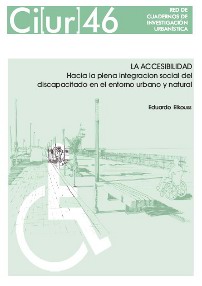
La accesibilidad. Hacia la plena integracion social del discapacitado en el entorno urbano y natural
Texto completo:
PDFResumen
Al cabo de varios años, y una vez reunido un amplio y variado material, me he planteado aproximarme al tema de manera sistemática y rigurosa, respecto a la Accesibilidad, considerando la integración social de las personas discapacitadas en la ciudad, al objeto de que me pudiese facilitar el inicio del camino para elaborar una investigación sobre la “accesibilidad al espacio público de la ciudad”, muy poco tratado y con utilidad para otras personas.
El análisis del material estudiado ha dado lugar a la PRIMERA PARTE de este trabajo, de contenido más denso, más conceptual, con la intención de establecer un marco teórico de referencia. Y en una SEGUNDA PARTE, he investigado una serie de casos prácticos de estudio donde los principios teóricos de la Accesibilidad son de aplicación, en la ciudad, en su entorno urbano o natural, en sus calles, plazas o parques. Esta labor de campo ha consistido en analizar “in situ” los distintos entornos seleccionados, buscando las realizaciones ejemplares que puedan ser aleccionadoras, más que la crítica de los errores o insuficiencias. Al terminar la Tesis Doctoral, me he detenido en unas CONCLUSIONES sobre la problemática de la Accesibilidad al espacio público en la ciudad, contemplado las necesidades de movilidad de las personas discapacitadas, y cómo debe ser enfocada su atención. Se presenta un resumen de la misma en esta publicación.
Abstract:
During the course of my life, working in both the public and the private sector, as local architect or freelance, I have found the problem of Accessibility; trying to solve it, consulting the matter and getting into it. I have realized its increasing importance. There are between 60 and 80 million disabled people in the European Union, the number of which is going to grow due to the ageing of the population. For the year 2020, it is foreseen that ¼ of the population will be over 60 years. We have to take into account that, nowadays, 70% of the disabled are of that age. For a period of time I have devoed myself to compiling all the material I could, from scant publications about the matter to articles of press circulating from Accessibility Courses, and from the Internet. I have also visited many cities, like Edmonton, Copenhagen, Berlin, Curitiba and Barcelona, and I have interviewed those responsible for the corresponding policies, accompanied by a notebook, a photographic camera and a drawing pad.
After several years, and once I had collected a wide and varied material, I have considered approaching the matter in a systematic and rigorous way, regarding Accessibility, and the social integration of disabled people into the city, with the aim that this could facilitate the start of the way to carry out research about the Accessibility to the public spaces of he city, which has been studied very little and which can be very useful to other people.
The analysis of the studied material has given place to the FIRST PART of this work, with a denser and more conceptual content, with the intention of establishing a Theoretical Frame of Reference. In the SECOND PART, I have researched a series of practical cases studies where the theoretical principles of Accessibility are applied, in the city, in its urban or natural environment, in its streets, squares or parks. The work in this field has entailed analyzing, in situ, the different selected environments, looking for the exemplary executions that can be instructive, more than criticizing the mistakes or inadequacies. At the end of this Doctoral Thesis, I have stopped to consider some CONCLUSIONS about the Problem of Accessibility to the public space of the city, studying the mobility needs of disabled people and how its attention must be approached.
Palabras clave
Enlaces refback
- No hay ningún enlace refback.

Este obra está bajo una licencia de Creative Commons Reconocimiento-NoComercial-SinObraDerivada 4.0 Internacional.
Editado en Madrid por Departamento de Urbanística y Ordenación del Territorio (ETSAM), UPM.








